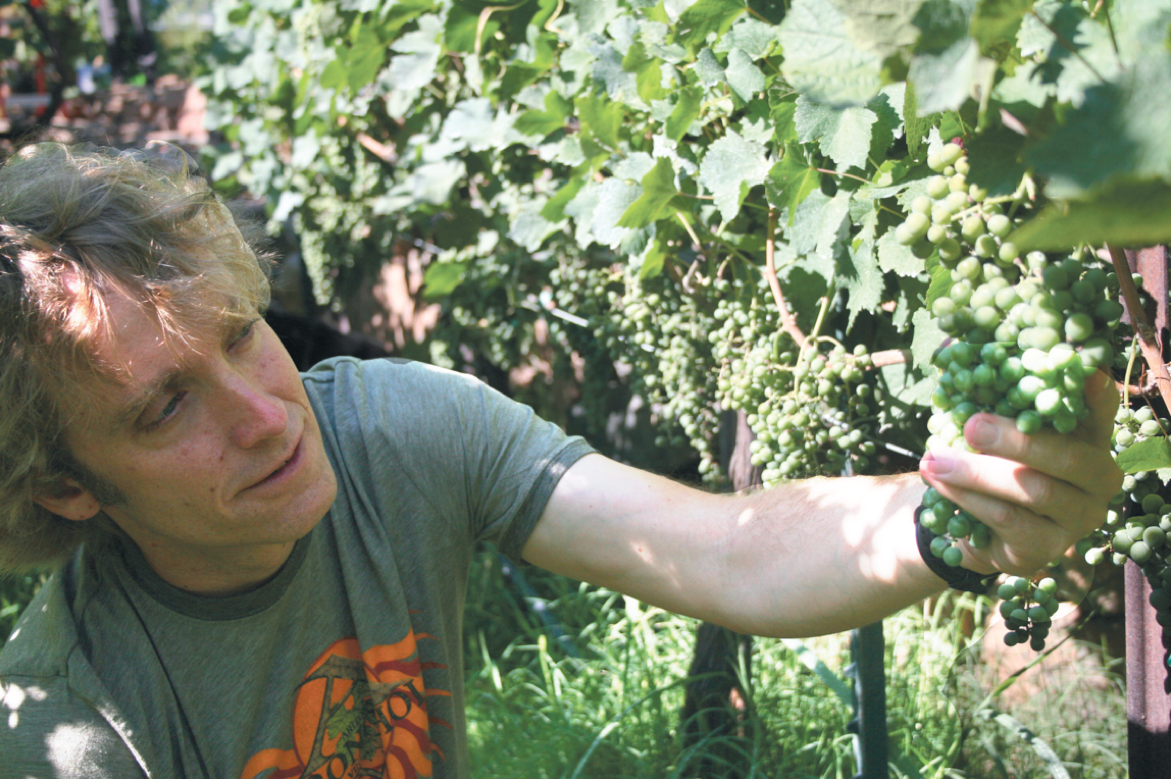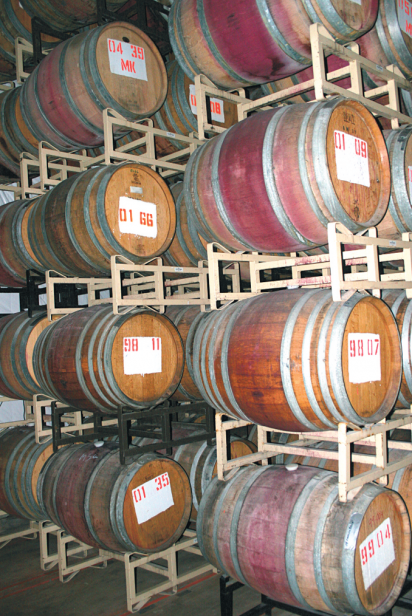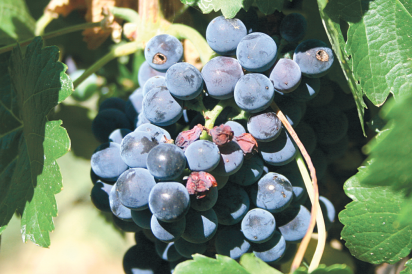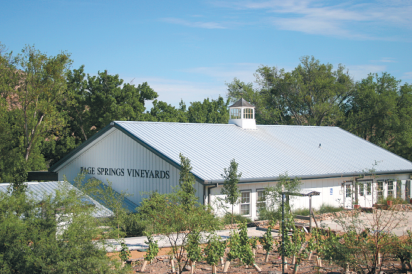Eric Glomski, Page Spring Cellars
Just like any other father, Eric Glomski wants to spend more time with his wife and kids. He wants to build a successful business and send his kids to college. Along the way, he wants to stop and smell the roses. Only in his case, he’s more likely to sniff the wafting bouquet of grapes.
That’s because Glomski, 41, is the winemaker and owner, along with his family, of Page Springs Cellars, an idyllic small winery tucked along a curvy road just north of Cornville, Arizona.
Glomski is also a partner in Arizona Stronghold Vineyards, along with Maynard Keenan, the front man in the alternative rock band Tool. As if that’s not enough to keep the fit, blue-eyed, boyish-looking Glomski busy, he makes wine for several others, too, including Keenan’s Caduceus label and the Pillsbury Wine Company, headed by filmmaker Sam Pillsbury. It’s hard to imagine he has any time to breathe at all.
Glomski built Page Springs Cellars with family in mind, and not just his own. It’s designed to be a gathering place, welcoming friends and family (and wine lovers) with a grapevine - family, ecology, ‘wine growing’ blend beautifully at page springs trellised path leading to a picnic deck overlooking picturesque Oak Creek. He just built a bocce ball court off to the side of the white, barn-like structure that houses a tasting room. Plans are in the works to add a kitchen that will serve tapas-style small plates. The second floor deck just off the tasting room overlooks the small, sloping vineyard below and rocky, creosote-covered hills above. By design, Page Springs Cellars will likely never grow much beyond the 4,500 cases per year Glomski currently produces.
Arizona Stronghold Vineyards, on the other hand, is positioned for a bigger audience. Glomski and Keenan have recently purchased an additional 160 acres in southern Arizona to add to the label’s existing 80 acres. With Keenan’s rock-star status and Glomski’s winemaking finesse, Arizona Stronghold Vineyards just might have the star power needed to catapult the brand onto a national stage. Glomski’s partnership (and friendship) with Keenan is the direct result of a shared philosophy about winemaking that begins with a sense of place and an intrinsic feeling of connectedness to the rugged Arizona landscape.
GO WEST, YOUNG MAN
Despite the fact that wine grapes were planted hundreds of years ago in southern Arizona by early missionaries, the first commercial winery wasn’t established until the late 1970s and it took another 20 years before the industry really began to take shape. Two wineries that couldn’t be further apart on the winemaking spectrum— Callaghan and Kokopelli—both began production at roughly the same time during the early ’90s. Although Callaghan produces high-end wines that appeal to connoisseurs and Kokopelli focuses on inexpensive wines with a broader appeal, both wineries played a pivotal role in propelling Arizona onto the viticulture scene.
At the same time that Callaghan and Kokopelli were first planting their vineyards, Glomski was scampering up and down miles of central Arizona rivers and creek beds as part of his work as a river consultant. Glomski studied ecology at Prescott College, eventually teaching river ecology before forming his own river restoration company. On assignment, he stumbled upon an abandoned apple orchard and gathered up a few bushels of the heirloom apples, intent on making cider. What he made instead was apple wine (unlike cider, apple wine has no carbonation and is higher in alcohol content). One sip of that homemade apple wine forever changed the course of his life. From that moment forward, he knew that winemaking was going to be his future.
Glomski headed to California on a quest to learn more about winemaking, picking up odd jobs at various wineries, eventually landing at the renowned David Bruce Winery. Starting as a harvest worker, he eventually worked his way up to co-winemaker and director of production. All the while, he had his heart set on returning to Arizona with visions of making his own wine in the high desert. Six years after he left Arizona, he returned, doing a brief winemaker stint at Echo Canyon before he and his family purchased the acreage where Page Springs Cellars now resides, bordered by Oak Creek to the north and national forest land to the west.
RENAISSANCE MAN
At heart, Glomski sees himself as a steward of the land. His background in ecology coupled with his profound love of the land drive him to craft wines that are reflective of the place where the grapes are grown. Does he consider himself a farmer? Not exactly.
“If I were to call myself anything, I’d call myself a wine grower,” he says. “I spend more time in the vineyards these days than I do in the cellar.” That’s partly because it’s the height of harvest season now, when everything else comes to a halt, and all energy is focused on the vineyards.
But Glomski’s more than just a farmer, so perhaps the nonexistent term wine grower isn’t that far off. He is director of winemaking for all his ventures, even though he has winemakers on staff. He’s also the sales and marketing guy, and occasionally, he’s the guy who fixes a busted irrigation line. He does it all, which suits him just fine.
“I’m a high-functioning ADD [attention deficit disorder] kind of guy,” he laughs. “I love dabbling and seeing connections between things. I could never be somebody who just focuses on one thing.”
Once he figured out the basics of winemaking, he realized that all great wine starts in the vineyard, so, if forced to choose one task, he tends to favor working the vines. For one thing, it keeps him outside surrounded by the natural beauty of the place he calls home. He even has a section of his estate vineyard that he manages himself, from irrigating to pruning to harvesting, using this plot to train his staff.
That’s not to say he doesn’t enjoy the other aspects of winemaking, specifically blending. Most of the wines Glomski makes are Rhone-style blends of several grape varieties, or within a varietal, blends from different vintages.
The vineyards (both at Page Springs and Arizona Stronghold) skew to classic northern and southern Rhone varietals—red grapes like Syrah, Grenache, Mourvedre and Petite Sirah, and the white varietals of Viognier, Roussane and Marsanne. The almost two dozen grape varietals spread across the various vineyards provide Glomski a palette of flavors from which to choose when creating the wines.
“Blending, to me, is really the ‘art’ of winemaking,” he says. “It’s just like being in a kitchen and you’ve got this big spice cabinet. How do you combine things? Well, classic flavor pairings are one approach. If you’ve got lamb, you might put rosemary on it. Beef might get cracked peppercorns. Eventually, you work your way out of the classics and start developing your own recipes.”
Even though Glomski could have the final say on the wine blending, he prefers to manage by consensus—which he thinks was the most important lesson he learned at David Bruce. Before the final decision is made on a particular wine blend, Glomski gathers the staff together for tasting and discussion. Everyone has a voice. Everyone is “family.”
FAMILY MAN
The pastoral scene at Page Springs Cellars isn’t just a mirage. The winery is home to Glomski and his wife and four children: their residence is perched on a hilltop just across the road. They spend time with him on the grounds, picking grapes during harvest, doing other chores during the rest of the year when the kids aren’t in school.
“It’s a lifestyle,” he says, “and it’s about family and relationships with people and with the land.”
His mother, stepfather, father and brother are also involved in the winery to varying degrees, all serving on the board of directors. His mother helps with the government compliance work. His stepfather helps with budgeting and forecasting. Even his sister-in-law contributes, sketching the pen-and-ink drawings for the wine labels. He shares that building Page Springs Cellars has helped rebuild a damaged relationship between his parents that resulted from their divorce.
“I’d say all of our relationships are 10 times better now that we are all united behind a common goal. It’s pretty wild,” he says. “The winery ended up healing my family.”
And nothing, not even a rosé, could be sweeter than that.
PAGE SPRINGS CELLAR
Where to buy: The best selection of Page Springs Cellars wines is available at the winery, although a few bottles wend their way to select Valley wine stores (A. J.’s, AZ Wine, others) and local restaurants (Binkley’s, Mosaic, noca). The winery also offers a Members Club. Visit the website for details.
Tasting room: Open to the public every day (yes, 365 days a year) from 11 a.m. to 6 p.m. Directions to the winery can be found on the website; it generally takes about 1 hour and 45 minutes to travel to the winery from central Phoenix.
Events: Currently in the midst of the 2009 harvest, Page Spring Cellars just celebrated its fourth annual “Under the Tree” harvest festival. Held on the Sunday before Labor Day, the family-oriented festival attracts 300 to 400 people annually to celebrate the wine harvest with musical guests, food and, of course, wine. For details about upcoming events and next year’s harvest festival, visit the website.







